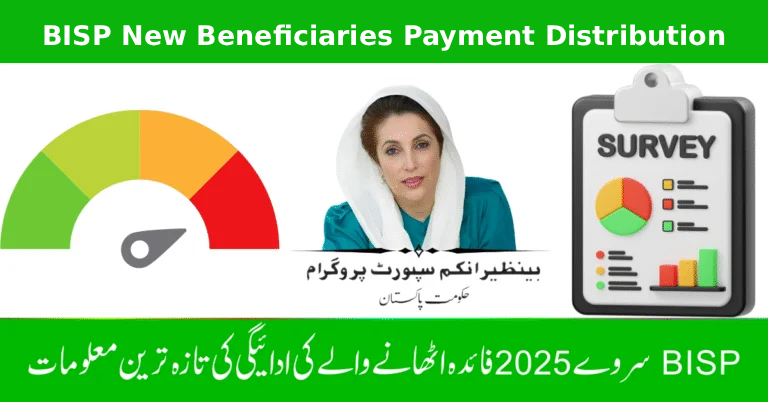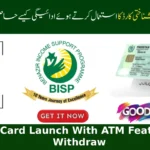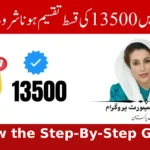
A Big Day for BISP Beneficiaries!
Hey there! If you’re reading this, you’re probably curious about the BISP New Beneficiaries Payment Distribution Will Be Start on 27 July Know Full Details. Well, you’re in the right place! The Benazir Income Support Programme (BISP) in Pakistan is like a superhero for millions of families, swooping in with financial help to make life a little easier. And guess what? Starting July 27, 2025, new beneficiaries are joining the party, getting their share of support to tackle everyday expenses like food, school fees, or those pesky utility bills.
Imagine getting a text that says you’re about to receive Rs. 13,500 to help with groceries or your kids’ books—that’s the kind of relief BISP brings! In this article, I’ll walk you through everything you need to know about this exciting update. From who qualifies to how you can check your status without breaking a sweat, I’ve got you covered. So, grab a cup of tea (or juice, if that’s your thing), and let’s dive into the details!
What Is BISP, Anyway?
Before we get to the juicy stuff, let’s quickly cover what BISP is for anyone who’s new to this. The Benazir Income Support Programme is Pakistan’s biggest social safety net, named after the inspiring Shaheed Benazir Bhutto. It started back in 2008 with a simple goal: help low-income families, especially women, by giving them cash to cover basic needs. Think of it as a helping hand for families who are struggling to make ends meet in a world where prices seem to climb faster than a kid on a jungle gym.
BISP’s main program, called Benazir Kafaalat, gives eligible families Rs. 13,500 every three months. That’s money you can use for whatever your family needs most—whether it’s rice and flour for the kitchen or pencils and notebooks for school. And now, starting July 27, 2025, new beneficiaries are being added to the list, which means more families will get this support. Exciting, right?
Latest Updates for 2025: What’s New with BISP?
Okay, let’s get to the good stuff—what’s happening with BISP in 2025? The program is always evolving to make sure it reaches the people who need it most. Here are the big updates you need to know about:
New Beneficiaries Are Joining the Program
Starting July 27, 2025, BISP is rolling out payments to thousands of new beneficiaries. These are folks who’ve recently been verified through the National Socio-Economic Registry (NSER) survey. If you’ve been waiting to hear if you’re eligible, this could be your moment!
Payment Amount Stays at Rs. 13,500
The quarterly payment for 2025 is Rs. 13,500 for most families, but there’s a rumor floating around that it might bump up to Rs. 14,500 later in the year. For now, though, expect Rs. 13,500 to hit your account or be handed out at payment centers.
Double Payments for Some Lucky Folks
Here’s something cool: some beneficiaries who missed earlier payments (like in May 2025) due to verification hiccups might get a double payment of Rs. 27,000. This is BISP’s way of making sure no one misses out because of a technical glitch.
New Payment Methods for Convenience
The government is making it easier to get your money. You can now collect payments through:
- HBL Konnect outlets: These are like mini-banks where you can withdraw cash after biometric verification.
- BISP campsites: Special payment centers set up in your area.
- Pakistan Post: A new pilot program lets you pick up your cash at post offices in some districts, which is super handy for folks in remote areas.
More Women Added to the Program
BISP is all about empowering women, and in 2025, they’ve added over 400,000 new female beneficiaries. If you’re a woman leading a household, you’re a priority for this program, which is pretty awesome.
Who Qualifies for BISP Payments in July 2025?
Not everyone can get BISP payments, so let’s break down who’s eligible. The program uses something called the Poverty Scorecard to figure out who needs help the most. Here’s what you need to qualify:
- Low-Income Household: Your family’s income should be below Rs. 50,000 per month, and you shouldn’t own fancy stuff like luxury cars or big properties.
- Female-Headed Households: If a woman is the main breadwinner or there’s no male earner, you’re more likely to qualify.
- Valid CNIC: You need an active, unblocked Computerized National Identity Card (CNIC). If yours is expired, head to NADRA to update it pronto!
- NSER Survey: Your family must be registered in the National Socio-Economic Registry. If you haven’t done this yet, don’t worry—I’ll explain how later.
- No Government Job or Big Pension: If someone in your family works for the government or gets a hefty pension, you might not qualify.
- Special Groups: Widows, disabled persons, and transgender individuals get extra consideration. Transgender applicants just need a CNIC marking their gender as transgender.
If you’re thinking, “Hmm, I might qualify,” keep reading to find out how to check your status!
How to Check If You’re a New Beneficiary
Wondering if you’re one of the lucky new beneficiaries starting July 27, 2025? Checking your status is super easy, and you don’t need to be a tech wizard. Here’s how you can do it:
Option 1: Send an SMS to 8171
- Grab your phone and open the messaging app.
- Type your 13-digit CNIC number (no dashes, just the numbers).
- Send it to 8171.
- Wait for a reply. It’ll tell you if you’re eligible, if your payment is ready, or if you need to do something else (like update your info).
Pro Tip: Make sure the SIM card you’re using is registered with your CNIC. If it’s not, you might not get a reply.
Option 2: Use the 8171 Web Portal
- Visit the official BISP website at 8171.bisp.gov.pk.
- Enter your CNIC number in the box.
- Type the captcha code you see on the screen (it’s just a quick way to prove you’re not a robot).
- Hit “Check” to see your status—whether you’re approved, pending, or need to update something.
Option 3: Visit a BISP Tehsil Office
If you’re not getting a reply via SMS or the website is acting up, head to your nearest BISP Tehsil Office. Bring your CNIC and any documents like utility bills or your kids’ B-Forms. The staff there can check your status and help with any issues.
Step-by-Step Guide to Collecting Your BISP Payment
So, you’ve checked your status and got the green light—congrats! Now, how do you actually get that Rs. 13,500? Here’s a simple guide to collecting your payment starting July 27, 2025:
- Confirm Your Payment Status: Double-check via SMS or the 8171 portal to make sure your payment is ready. This saves you from a wasted trip to a payment center.
- Find Your Payment Center: Your SMS or the BISP website will tell you where to go. It could be an HBL Konnect outlet, a BISP campsite, or a post office in some areas.
- Bring the Right Stuff:
- Your original CNIC (not a copy).
- The SMS confirmation or NSER survey receipt, if you have one.
- A big smile (okay, that’s optional, but it helps!).
- Do Biometric Verification: At the payment center, you’ll need to scan your fingerprint to prove it’s you. This keeps things secure and makes sure the money goes to the right person.
- Collect Your Cash: Once verified, you’ll get your Rs. 13,500 in cash or through a direct bank transfer if you’ve got a BISP Sahulat Account.
Important Note: Never pay anyone to “help” you get your payment. BISP services are free, and anyone asking for a fee is probably trying to scam you. If something feels off, call the BISP helpline at 0800-26477.
Benefits of BISP Payments: Why It Matters
You might be wondering, “Okay, Rs. 13,500 is nice, but what’s the big deal?” Well, this money can make a huge difference for families. Here’s how:
- Food on the Table: With prices going up, Rs. 13,500 can buy essentials like rice, flour, oil, and veggies to keep your family fed.
- Kids in School: The extra cash can cover school fees, uniforms, or books, so your kids don’t miss out on education.
- Healthcare Help: Need medicine or a doctor’s visit? This money can help cover those costs.
- Empowering Women: Since payments go to women, it gives them more control over household spending, which is a big step toward independence.
- Small Business Boost: Some women use the money to start tiny businesses, like selling snacks or sewing clothes, to earn extra income.
Plus, BISP isn’t just about cash. Programs like Benazir Taleemi Wazaif give extra money for kids in school, and Benazir Nashonuma helps pregnant women and young kids with nutrition. It’s like a whole package of support!
Common Mistakes to Avoid When Collecting BISP Payments
Nobody wants to mess up and miss their payment, so let’s talk about some common slip-ups and how to avoid them:
- Using an Expired CNIC: If your CNIC is out of date, you won’t get paid. Head to NADRA to renew it before July 27.
- Ignoring SMS Alerts: If you get a text from 8171, read it carefully. It’ll tell you where and when to collect your money.
- Going to the Wrong Center: Each district has specific payment points. Check your SMS or the BISP website to find the right one.
- Falling for Scams: If someone says they can “speed up” your payment for a fee, run the other way! Only trust official BISP channels.
- Not Updating NSER Data: If your family’s situation has changed (like a new baby or a move), update your info at a BISP office to stay eligible.
How to Register as a New Beneficiary
If you’re not yet part of BISP but think you qualify, don’t worry—you can still join! Here’s how to register:
- Visit a BISP Tehsil Office or NSER Center: There’s no online registration, so you’ll need to go in person. Check the BISP website for the nearest location.
- Bring Your Documents:
- Original CNIC (must be valid).
- B-Forms for your kids, if you have any.
- A recent utility bill to confirm your address (not always required, but good to have).
- Fill Out the NSER Survey: An official will ask you questions about your income, assets, and family to calculate your Poverty Score. Be honest—this decides if you qualify!
- Get a Receipt: After the survey, you’ll get a slip confirming your application. Keep it safe in case you need to follow up.
- Wait for Verification: BISP will check your info with NADRA. If you’re approved, you’ll get an SMS telling you when and where to collect your payment.
Quick Tip: If you’re in a remote area, look out for BISP mobile vans. They set up temporary camps to reach far-off villages, making registration easier.
What to Do If You Face Payment Issues
Sometimes, things don’t go as smoothly as planned. Maybe your payment is delayed, or your biometric verification isn’t working. Don’t panic—here’s how to fix common problems:
- No SMS Reply: If you sent your CNIC to 8171 and got nothing back, wait a few hours and try again. If it still doesn’t work, visit a BISP office.
- Biometric Failure: If your fingerprints don’t match, go to a NADRA office to update your records, then try again at the payment center.
- Payment Not Released: Check your status on the 8171 portal. If it says “pending,” it might just be a delay due to high demand. Keep checking every few days.
- Lost BISP Card: If you have a BISP ATM card and lose it, report it at a BISP office or bank branch to get a replacement.
- Scammed or Asked for a Fee: Report it immediately to the BISP helpline (0800-26477) or your local Tehsil Office. You should never pay to get your money.
Why BISP Is a Game-Changer for Pakistan
BISP isn’t just about handing out cash—it’s about changing lives. By focusing on women, the program empowers them to make decisions for their families. It’s like giving them a megaphone to say, “Hey, I’ve got this!” The money helps families stay afloat during tough times, like when inflation makes everything more expensive. Plus, programs like Taleemi Wazaif and Nashonuma are investing in the future by keeping kids in school and healthy.
In 2025, BISP is also working on cool new stuff, like digital payment options and skills training for women. Imagine learning to sew or start a small shop with BISP’s help—that’s the kind of impact we’re talking about!
Conclusion: Get Ready for July 27, 2025!
Alright, friends, that’s the full scoop on the BISP New Beneficiaries Payment Distribution Will Be Start on 27 July Know Full Details! Whether you’re a new beneficiary or just curious, I hope this guide made things super clear. Starting July 27, 2025, thousands of families will get Rs. 13,500 to help with life’s essentials, and some might even score a double payment of Rs. 27,000. How cool is that?
If you’re eligible, check your status, grab your CNIC, and head to your payment center. If you’re not registered yet, visit a BISP office to get started. And most importantly, stay smart—don’t fall for scams, and always use official channels like the 8171 portal or helpline.
This money is your lifeline, so make the most of it. Buy those school supplies, stock up on groceries, or maybe treat your family to something special. You’ve got this! If you have any questions, check out the FAQs below or drop by a BISP office. Here’s to a brighter, easier July!
FAQs: Your Top Questions Answered
Q1: How much money will I get from BISP in July 2025?
You’ll get Rs. 13,500 per quarter as a regular payment. Some people might get Rs. 27,000 if they missed an earlier payment.
Q2: Can I check my BISP status without the internet?
Yup! Just send your 13-digit CNIC number to 8171 via SMS, and you’ll get a reply with your status.
Q3: What if I don’t get my payment on July 27?
Don’t stress! Payments are released in phases, so it might take a few days. Check your status on the 8171 portal or call the helpline at 0800-26477.
Q4: Can I register for BISP online?
Nope, you have to visit a BISP Tehsil Office or NSER center in person to register. Bring your CNIC and other documents.
Q5: What if someone asks me to pay to get my BISP money?
That’s a scam! BISP services are free. Report anyone asking for money to the BISP helpline or your local office.
Q6: Who gets priority for BISP payments?
Women leading households, widows, disabled persons, and transgender individuals are top priorities. Your Poverty Score also needs to be below 32 (or 37 for families with a disabled person).

